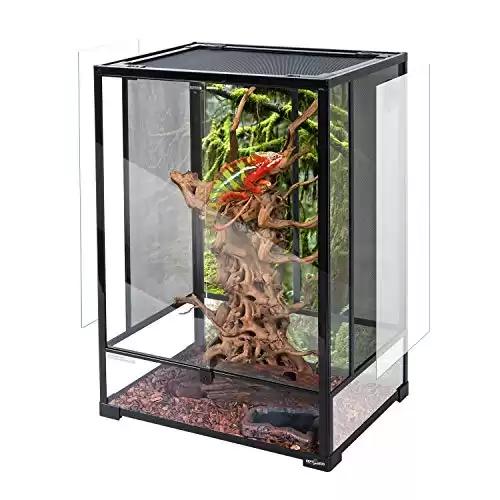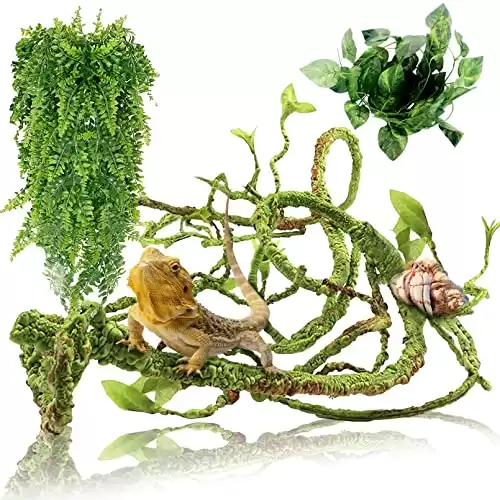Are you ready to dive into the enchanting world of panther chameleons? These remarkable reptiles are more than just pets; they’re nature’s living artworks. With their captivating ability to change colors, they’ll keep you mesmerized and entertained.
In this article, we’ll take you on a journey to discover the charm of these pet chameleons, from their vibrant personalities to the secrets of their color-changing magic. Get ready!
How Do Panther Chameleons Look?
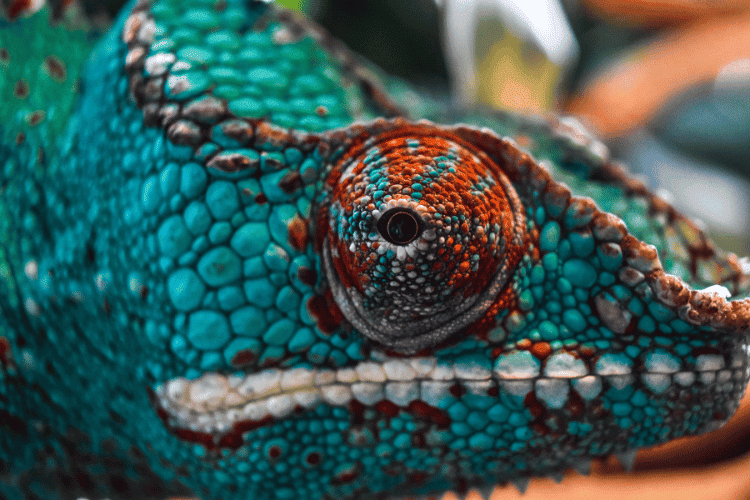
These captivating creatures are a true spectacle of nature. They’re known for their eye-catching colors, especially the males who sport a rainbow palette that can rival any artist’s masterpiece.
As such, males take the lead in the color department with a striking broken white stripe that runs the length of their body, like a bold fashion statement. Meanwhile, the ladies, although less flamboyant, exude an elegant charm in shades of tan, gray, or pale green.
But there’s more to these colorful characters than just their dazzling exterior – these chameleons have some truly fascinating features. Males boast a prominent “helmet” or casque, which isn’t just a fashion accessory but serves as protection.
Their extra-long, sticky-tipped tongue is like a precision instrument for capturing prey, launching forward in a frog-like catapult style. Their large, dome-shaped eyes give them a wide field of view, perfect for spotting insects from afar.
Then there’s their specially jointed legs that are designed for acrobatics, allowing them to grasp branches with all four V-shaped feet. It’s like having built-in hooks for climbing. Their prehensile tails, which curl when not in use, add an extra touch of charm to their appearance.
Where Do Panther Chameleons Live?
Panther chameleons are native to the northern and coastal regions Madagascar, including forests, woodlands, and savannas.
You’ll mostly find them in the coastal lowlands, however, where the weather is warm and humid. The temperature there typically ranges from 75°F to 85°F (or 24°C to 40°C).
Males, in particular, have a taste for the high life, residing at higher elevations, possibly for territorial reasons.
It’s in these warm and humid coastal areas that these colorful chameleons feel right at home, basking in the gentle tropical breezes and thriving amidst the lush greenery.
What Is the Ideal Captive Habitat for Panther Chameleons?
Panther Chameleons like their space, especially when it comes to height. A 2’x2’x4′ (60 x 60 x 120 cm) enclosure is the minimum recommended size for a single chameleon.
If you can provide a larger 4’x2’x4′ enclosure, even better! Larger spaces allow them to express their natural behaviors and feel comfortable.
Our chameleons are diurnal as well, meaning they’re most active during the day, so they need their daylight. Provide 12 hours of bright light and UVB daily. To ensure the right UVB strength, consider the distance between the bulb and your chameleon.
For temperature regulation, offer a basking area at 85-90°F (29-32°C) and a general temperature range of 72-77°F (22-25°C).
Nights can be cooler at 60-70°F (15-21°C). A
Humidity levels should be around 50-60% during the day and 75-100% at night. To maintain these levels, use a pump-style pressure sprayer for daily misting and consider a cool mist
Branches, vines, and live or artificial plants make great décor too. Secure them using zip ties looped through the mesh. Live plants not only look great but also help maintain humidity.
Arrange the décor to encourage climbing, exploring, basking, and hiding. It’s like decorating a treehouse for your chameleon!
By providing your chameleon with a spacious, well-lit, and comfortable environment, you’ll ensure they live their best and most colorful life.
What Are the Ideal Tank Mates for Panther Chameleons?
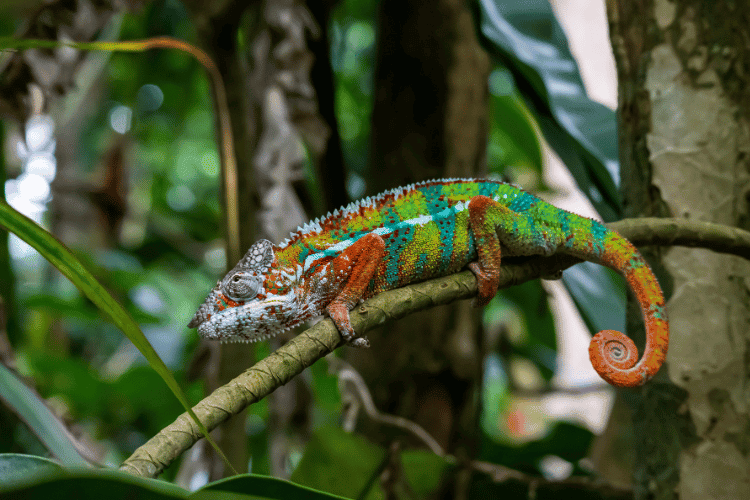
First and foremost, it’s crucial to understand that panther chameleons are generally solitary creatures in the wild. They prefer to have their own space and don’t actively seek out company.
In their natural habitat, they may cross paths with other chameleons occasionally, but these encounters are often for mating purposes rather than forming social bonds.
Males, specifically, tend to be highly territorial and aggressive towards other males, especially when it comes to defending their turf. They might view any potential intruder, even of a different species, as a threat.
What Are the Feeding Habits of Panther Chameleons?
Panther chameleons have a hearty appetite for live prey, and they have their favorites.
While crickets are a top choice, they also relish mealworms, super worms, waxworms, and various other insects. The key is to offer a variety to ensure a well-rounded diet. Think of it as a smorgasbord of bugs for your colorful companion!
As for the frequency of feeding, it depends on your chameleon’s age. Baby panther chameleons are growing rapidly, so they require more frequent meals.
Offering insects everyday or every other day is ideal for youngsters. As they mature, you can gradually reduce the frequency to every 2-3 days for adults.
Ensuring the insects you offer are nutritious is crucial as well. To do this, practice gut-loading, which involves feeding the insects a nutritious diet before offering them to your chameleon. This way, your chameleon receives all the goodness from its prey.
Additionally, dusting the insects with
What Is the Temperament of Panther Chameleons?
While each chameleon has its unique personality, they tend to have a generally docile demeanor, especially when compared to other lizards. This friendly disposition makes them a favorite among lizard pet owners.
One important thing to note about these friendly chameleons is that they’re primarily an observation pet rather than a hands-on companion.
They’re not known for enjoying handling or physical interaction with humans—although, you can teach them to tolerate it for short periods. Just remember: these chameleons can become stressed when handled, and it’s essential to respect their boundaries.
If you must handle them for health checks or enclosure maintenance, approach with care. Use slow, deliberate movements, and avoid sudden gestures or loud noises that can startle them.
These chameleons also communicate through body language, and it’s important to pay attention to their cues. Dark colors, hissing, or puffing up are signs of stress or discomfort. If you notice these behaviors, it’s best to give your chameleon some space and minimize handling.
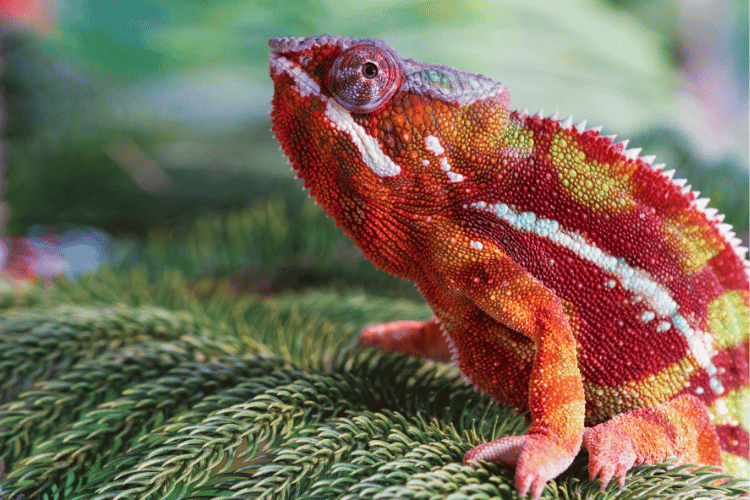
What Are the Common Health Issues for Panther Chameleons?
By being proactive in your chameleon’s care and promptly addressing any signs of illness, you can help ensure a long and healthy life for your colorful companion.
- Stress: This species of chameleons are sensitive creatures and can become stressed easily, which can lead to health problems. Ensure their habitat provides adequate hiding spots and privacy to help reduce stress.
- Eye Infections: Keep an eye on your chameleon’s eyes. If you notice any discharge, swelling, or changes in eye color, it could be a sign of infection. Prompt veterinary care is essential.
- Parasites: Internal and external parasites can affect any chameleon. Routine fecal examinations by a reptile veterinarian can help detect and treat parasitic infections.
- Kidney Failure: This is a significant concern for panther chameleons. Ensure they have access to clean water and maintain proper humidity levels in their enclosure to support kidney health.
- Gout: Gout is a condition caused by the accumulation of uric acid crystals in joints. To prevent it, maintain proper hydration and monitor their diet to avoid excessive purine-rich foods.
- Metabolic Bone Disease (MBD): MBD is a common issue in pet chameleons, often caused by a lack of proper UVB lighting or
calcium deficiency. Ensure they receive adequate UVB exposure and provide acalcium supplement.
What Are the Lifespan and Size of Panther Chameleons?
These enchanting creatures start small, with females measuring in at 10 to 14 inches in length and weighing between 60 to 100 grams.
Both males and females share this similar size range.
The male chameleon typically enjoys a lifespan of four to seven years.
In contrast, females tend to have a somewhat shorter lifespan of around two to three years.
What Are the Breeding Habits of Panther Chameleons?
Panther chameleons are typically solitary creatures, but they come together for one purpose—mating.
After a gestation period lasting 30 to 45 days, the female descends from her arboreal perch to the ground. There, she takes on the role of an architect, digging a burrow where the magic will happen.
In this carefully crafted burrow, the female lays a clutch of eggs, which can range from 14 to 34 in number, with an average of 20 eggs. Fun fact: Once the eggs are laid, the female has no further involvement in their development except for turning them regularly.
As such, these chameleon hatchlings are independent from the moment they break free from their eggs. They embark on their own journey into the world, ready to embrace the adventures of life.
Are There Legal Considerations for Owning a Panther Chameleon?
Before inviting this species of chameleons into your home, it’s essential to be aware of any legal requirements or restrictions that may apply to these captivating reptiles.
Panther chameleons are legal to own as pets in all 50 states, but there may be some local restrictions. For example, some cities and counties may have ordinances that prohibit the ownership of certain exotic pets.
The legal status of owning this particular chameleon can vary by region and jurisdiction. What’s permissible in one area might not be the same in another.
The IUCN Red List, for example, provides information on the conservation status of chameleons in different regions. Check their site for more information.
Additional Resources
- Books:
- “Panther Chameleon Owners Guide. The Captive Care of Panther Chameleons, Including Biology, Behavior and Ecology” by Ben Team
- “Panther Chameleon Owner’s Manual: Panther Chameleon book for care, feeding, handling, health and common myths” by Jonathan Durham
- “Panther Chameleon: The Ultimate Panther Chameleon Pet Owner’s Manual” by Lolly Brown
- Forums:
- OurReptileForum.com
- Chameleonforums.com
Case Study
Meet Carolyn! A friendly panther chameleon that’s a house resident at FramsChams (@framschams_chameleons). She’s rather cheeky and playful around her human friends.
FAQs
Are panther chameleons friendly?
Panther chameleons are known for their generally docile demeanor, making them relatively friendly among reptile species. However, they prefer observation over handling.
What is unique about panther chameleons?
What makes these intriguing chameleons stand out is their breathtaking color-changing ability, vibrant displays during mating, and their distinctive casques (helmets) on males.
What is the average price of a panther chameleon?
Prices vary based on factors like coloration and age, but on average, you can expect to invest between $150 to $350 for this chameleon type.
Do panther chameleons change color?
Absolutely! Panther chameleons are masters of camouflage. They change color to communicate, regulate body temperature, and express their emotions, making them truly captivating creatures to observe.
Equipment Needed
- Enclosure
- Proper lighting (UVB and basking)
- Heat source (ceramic heat emitter)
- Humidity gauge
- Thermometer
- Misting system or spray bottle
- Substrate (drainage system)
- Live or artificial plants
- Climbing branches and vines
- Feeder insects
- Calcium and multivitamin supplements
- A water source

